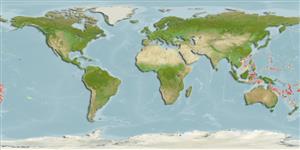Common names from other countries
>
Anguilliformes (Eels and morays) >
Ophichthidae (Snake eels) > Ophichthinae
Etymology: Ophichthus: Greek, ophis = serpent + Greek, ichthys = fish (Ref. 45335); mystacinus: Specific name from a Greek word meaning mustachioed..
More on author: McCosker.
Environment: milieu / climate zone / depth range / distribution range
Ecologia
marino batidemersale; distribuzione batimetrica 371 - 824 m (Ref. 84366). Deep-water
Western Pacific: New Caledonia, Tonga, Fiji, and the Philippines.
Size / Peso / Age
Maturity: Lm ? range ? - ? cm
Max length : 42.9 cm TL maschio/sesso non determinato; (Ref. 31795)
Short description
Chiavi di identificazione | Morfologia | Morfometria
Vertebre: 162 - 177. This moderately elongate species of Ophichthus, subgenus Coecilophis is distinguished by the following characters: tail 59-60%, head 10.7-11.7% of total length, body depth behind gill openings 3.6-4.3% of TL; origin of dorsal-fin about mid-trunk; elongate pectoral fins with the central rays threadlike; posterior margin of orbit ahead of rictus; small and inconspicuous head pores, SO 1+4, IO 4+2, POM 2+6; small, conical and numerous teeth, biserial in jaws and anteriorly on vomer; yellowish tan in color, brown dorsally, fins and anterior nostrils pale; snout tip smudged but not blackened; mean vertebral formula 34.2/61.3/169.7, total vertebrae 162-177 (Ref. 84366).
Life cycle and mating behavior
Maturities | Riproduzione | Spawnings | Egg(s) | Fecundities | Larve
McCosker, J.E., 1999. Pisces Anguilliformes: deepwater snake eels (Ophichthidae) from the New Caledonia region, Southwest Pacific Ocean. p. 571-588. In A. Crosnier (ed.) Résultats des Campagnes Musorstom, Volume 20. Mémoires du Muséum national d'Histoire naturelle: 180. (Ref. 31795)
IUCN Red List Status (Ref. 130435)
CITES (Ref. 128078)
Not Evaluated
Threat to humans
Harmless
Human uses
Pesca: di nessun interesse
Strumenti
Special reports
Download XML
Fonti Internet
Estimates based on models
Preferred temperature (Ref.
115969): 6.5 - 12.3, mean 8.1 (based on 156 cells).
Phylogenetic diversity index (Ref.
82804): PD
50 = 0.5000 [Uniqueness, from 0.5 = low to 2.0 = high].
Bayesian length-weight: a=0.00089 (0.00039 - 0.00204), b=3.00 (2.80 - 3.20), in cm Total Length, based on LWR estimates for this (Sub)family-body shape (Ref.
93245).
Trophic level (Ref.
69278): 3.8 ±0.7 se; based on size and trophs of closest relatives
Resilienza (Ref.
120179): Basso, tempo minimo di raddoppiamento della popolazione 4.5 - 14 anni (Assuming tmax>10).
Fishing Vulnerability (Ref.
59153): Low to moderate vulnerability (33 of 100).
